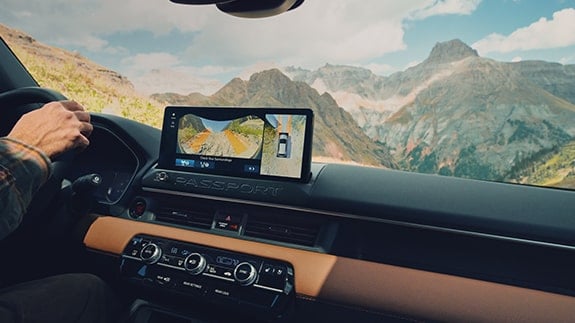The concept of the stop-start system is simple. It automatically shuts off the engine when the vehicle is at rest to cut fuel use and eliminate idle emissions. It then restarts the engine automatically when the driver lifts off the brake (or puts in the clutch to select 1st gear) to get going again. The basic logic is hard to argue with. Why burn gasoline if you're just sitting there?
Such systems used to be reserved for only the most fuel-efficient cars, usually hybrids, but in the last couple years they've begun appearing in the U.S. on vehicles with conventional gasoline engines. Even the best-selling 2015 Ford F-150 will come with stop-start if you choose the new 2.7-liter EcoBoost gasoline engine.
Stop-start systems are gaining momentum in a hurry, but how do they work? And do they really save that much fuel?
How Much Can You Save?
It turns out the effects of stop-start systems aren't baked into the EPA fuel economy estimates for the very cars that use such systems. The official city test pattern has plenty of stops, but there's not nearly as much idle time as many of us deal with every day. It's entirely possible that a stop-start car could exceed its own city mpg rating with the system engaged.
The engineers we asked about potential fuel savings always spoke in terms of a range of 3-10 percent, with some venturing as high as 12 percent. The wide span accounts for the variety of driving conditions out there. People who pause briefly at four-way stops have less to gain than those who sit idle at numerous long signals. The longer you sit, the more you save.
It boils down to this. If your car usually manages 20 mpg in the city, it could earn 22 or 23 mpg if it had a stop-start system.
A Test Is in Order
Such unsatisfyingly vague claims weren't enough for us. So we gathered three newly redesigned cars from our long-term test fleet for a test: the all-new 2014 Mini Cooper (1.5-liter turbocharged three-cylinder), 2014 BMW 328i GT (2.0-liter turbocharged four-cylinder) and the 2015 Jaguar F-Type R (5.0-liter supercharged V8). All are automatics and all came with stop-start as standard equipment. And all use costlier premium fuel, which increases the money-saving potential.
And yes, they're all European. European-designed cars are presently the most common non-hybrid examples to use stop-start because gasoline costs nearly three times as much in their home market as it does here. There's a lot of home-grown consumer demand for this technology. You might demand it yourself if gasoline cost upward of $7 per gallon.
We used a modified version of our 106-mile suburban Orange County hybrid test loop, chopping out the longer stretches that lack stops. The resulting 80.4-mile stop-start test loop takes about three hours to complete. We ran each car at least two times on back-to-back days with the same start time: once with the system on and again 24 hours later with the system off.
Before we reveal the results, here's how the systems work.
More Changes Than You Think
Several vehicle alterations are necessary to make stop-start viable. You can't get the same effect by keying off your car manually.
First off, the starter motor has to be more robust so it stays reliable despite being used far more often. Likewise, the battery must have deep cycle capability that can endure more frequent draws from the starter. And the engine's crankshaft and rod bearings need to have special low-friction coatings to handle the extra loads placed on them during frequent restarts.
On a more practical note, you don't want the stereo, fan, lighting or wipers to shut down each time the engine winks off, and you don't want them to hiccup when it starts up again. The entire electrical system must be laid out in a different way.
Because the engine will be off, electric pumps are necessary to keep engine coolant circulating and to maintain hydraulic pressure in the transmission. The air-conditioning system may have additional humidity and temperature sensors to monitor the core temperature of the system during the shutdown period. If it looks as if the passengers might get too warm, the computer can abandon the shutdown cycle.
That's right, there's a software brain behind all of this that decides when to stop and when to start again. Nominally, the engine stops when speed reaches zero. But the computer first needs to see steady brake pressure and little or no steering: evidence of a routine stop. The command to start again is given as the brakes are released (or the clutch is depressed) in order to get the engine back on line before the driver has time to transfer his foot to the gas pedal.
Making the Systems Less Intrusive
The mechanical bits are the easy part. It's quite another thing to make the system seamless and easy to live with. It's no good if the driver becomes annoyed and seeks out the "off" button.
Quick restarts are a big plus. And by quick, some engineers mean under 500 milliseconds (otherwise known as a half-second). The restarts must also be as smooth and seamless as possible; the engine shouldn't be permitted to shudder very much in its mounts. It's also best if the car is generally quiet and has low idle vibration. Any large difference between the utter quiet and stillness of engine-off and engine-on will draw undue attention.
The issue of "reset speed" factors in as well. At especially long signals you'd like to be able to move up if the cars ahead pack tighter and still be able to drop back into engine-cut mode after they stop again.
Our Test Results
For the first couple of tests we attempted to capture the maximum difference, so we ran the BMW and the Jaguar with the air-conditioning off in order to prevent premature restarts triggered by rising cockpit temperatures. Consider it the spring/fall scenario with the windows cracked to let some fresh air inside.
Our 328i GT used 3.1 gallons with the system off and 2.8 gallons with it on, a savings of 9.5 percent. That works out to 91 cents saved in 80 miles. Calculated fuel economy rose from 26.2 to 28.7 mpg.
The Jaguar did a little better, which makes sense when you're talking about a thirstier V8. It consumed 4.1 gallons with the system off and 3.6 with it on, a reduction of some 10.9 percent. At local prices that returned $1.47 to our pocket. Corresponding fuel economy increased from 19.7 to 22.1 mpg.
This, of course, begs the question of what would have happened if we had run the air-conditioning on a hot day. We saved that test for the Mini Cooper. We ran both loops with the automatic temperature control set to 74 degrees.
It used 2.7 gallons with A/C on and stop-start off, and that shrank slightly to 2.6 gallons with stop-start up and running. That works out to a modest fuel savings of 2.9 percent, with fuel economy climbing from 30.0 to 30.9 mpg. At this point we ran a third loop with the system engaged and the air-conditioning off and the savings shot up to 9.5 percent at 33.2 mpg.
What We Learned Along the Way
Hot weather and the use of air-conditioning have a distinct negative effect. The biggest gains come in mild weather. Some cars have an Eco air-conditioning setting that's designed to fall between our two data points. The Mini has such a feature, but the weather cooled before could make the fourth test run.
It's important to resist the temptation to inch forward if the car ahead creeps up while the light is still red. Once a stop-start car restarts, it won't shut down the engine again unless you exceed a certain minimum velocity that's higher than the typical signal-creep speed.
Whenever practical, sit still with your foot on the brake until it's really time to go.
Of course a slight creep can be your friend if you want to force a premature restart for some reason. If you don't have room to let the car inch forward you can also force a restart by tugging on the steering wheel instead. Stop-start cars have electronic power steering and the engine will start to support it.
The Verdict
All three of our test subjects delivered the estimated 10 percent in city traffic. People who live in particularly tough traffic areas with long wait times could do even better.
And the systems were mostly easy to live with. Restarts were fairly seamless and seemed appropriately quick for drivers who use the same foot for throttle and brake. Two-footed drivers who left-foot brake, on the other hand, could find themselves ahead of the engine restart cycle.
Stop-start is hard to ignore in a loud car like the Jaguar. This technology seems most ideally suited to cars that idle so quietly you barely know they're running. The F-Type gets away with it, though, because the snarling restart note of its powerful V8 is entertaining enough that you don't mind hearing it over and over.
Functionally, stop-start doesn't take very long to get used to — in our three test cars, at least. The biggest obstacle is mental: overcoming that sinking feeling that your engine just died. Once you get past that, you'll welcome the silence.
On the other hand, if it turns out you just don't like it or it doesn't suit your driving style that "off" button is not far out of reach.


